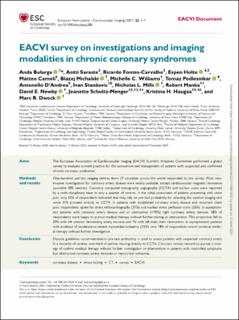| dc.contributor.author | Bularga, Anda | |
| dc.contributor.author | Saraste, Antti | |
| dc.contributor.author | Fontes-Carvalho, Ricardo | |
| dc.contributor.author | Holte, Espen | |
| dc.contributor.author | Cameli, Matteo | |
| dc.contributor.author | Michalski, Blazej | |
| dc.contributor.author | Williams, Michelle C. | |
| dc.contributor.author | Podlesnikar, Tomaz | |
| dc.contributor.author | D'Andrea, Antonello | |
| dc.contributor.author | Stankovic, Ivan | |
| dc.contributor.author | Mills, Nicholas L. | |
| dc.contributor.author | Manka, Robert | |
| dc.contributor.author | Newby, David E. | |
| dc.contributor.author | Schultz-Menger, Jeanette | |
| dc.contributor.author | Haugaa, Kristina | |
| dc.contributor.author | Dweck, Mark R. | |
| dc.date.accessioned | 2021-04-15T10:17:37Z | |
| dc.date.available | 2021-04-15T10:17:37Z | |
| dc.date.created | 2021-04-03T12:15:20Z | |
| dc.date.issued | 2021 | |
| dc.identifier.citation | European Heart Journal-Cardiovascular Imaging. 2021, 22 (1), 1-7. | en_US |
| dc.identifier.issn | 2047-2404 | |
| dc.identifier.uri | https://hdl.handle.net/11250/2737894 | |
| dc.description.abstract | Aims
The European Association of Cardiovascular Imaging (EACVI) Scientific Initiatives Committee performed a global survey to evaluate current practice for the assessment and management of patients with suspected and confirmed chronic coronary syndromes.
Methods and results
One-hundred and ten imaging centres from 37 countries across the world responded to the survey. Most non-invasive investigations for coronary artery disease were widely available, except cardiovascular magnetic resonance (available 40% centres). Coronary computed tomography angiography (CCTA) and nuclear scans were reported by a multi-disciplinary team in only a quarter of centres. In the initial assessment of patients presenting with chest pain, only 32% of respondents indicated that they rely on pre-test probability for selecting the optimal imaging test while 31% proceed directly to CCTA. In patients with established coronary artery disease and recurrent chest pain, respondents opted for stress echocardiography (27%) and nuclear stress perfusion scans (26%). In asymptomatic patients with coronary artery disease and an obstructive (>70%) right coronary artery stenosis, 58% of respondents were happy to pursue medical therapy without further testing or intervention. This proportion fell to 29% with left anterior descending artery stenosis and 1% with left main stem obstruction. In asymptomatic patients with evidence of moderate-to-severe myocardial ischaemia (15%), only 18% of respondents would continue medical therapy without further investigation.
Conclusion
Despite guidelines recommendations pre-test probability is used to assess patients with suspected coronary artery in a minority of centres, one-third of centres moving directly to CCTA. Clinicians remain reticent to pursue a strategy of optimal medical therapy without further investigation or intervention in patients with controlled symptoms but obstructive coronary artery stenoses or myocardial ischaemia. | en_US |
| dc.language.iso | eng | en_US |
| dc.publisher | Oxford University Press | en_US |
| dc.rights | Navngivelse-Ikkekommersiell 4.0 Internasjonal | * |
| dc.rights.uri | http://creativecommons.org/licenses/by-nc/4.0/deed.no | * |
| dc.title | EACVI survey on investigations and imaging modalities in chronic coronary syndromes | en_US |
| dc.type | Peer reviewed | en_US |
| dc.type | Journal article | en_US |
| dc.description.version | publishedVersion | en_US |
| dc.source.pagenumber | 1-7 | en_US |
| dc.source.volume | 22 | en_US |
| dc.source.journal | European Heart Journal-Cardiovascular Imaging | en_US |
| dc.source.issue | 1 | en_US |
| dc.identifier.doi | 10.1093/ehjci/jeaa300 | |
| dc.identifier.cristin | 1902012 | |
| cristin.ispublished | true | |
| cristin.fulltext | original | |
| cristin.qualitycode | 2 | |

